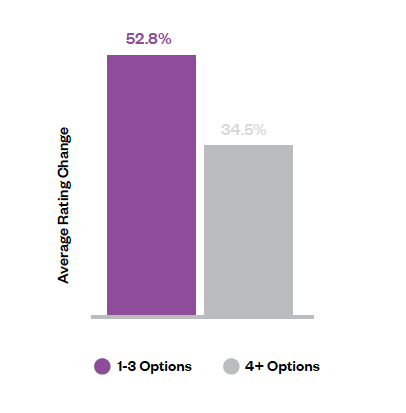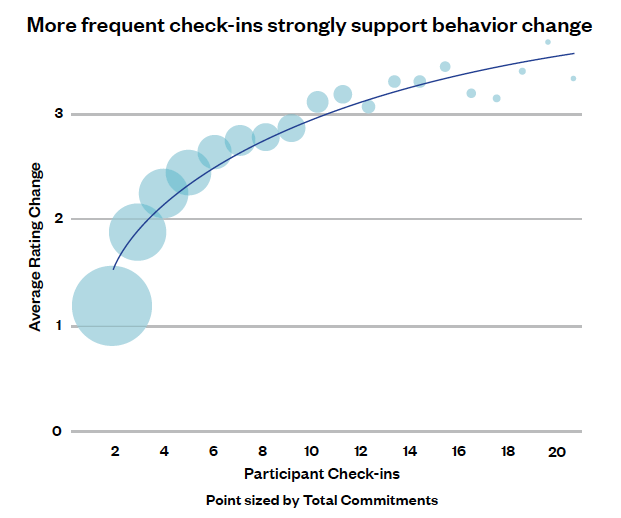2023 marks the 5th year that the team at Actionable has conducted an “Annual Insights” Study; a deep dive into the behaviors that corporate training program designers utilize, and their resulting impact on, well, impact.
We strongly believe that the purpose of corporate training programs is to move the needle on the strategic priorities that necessitated them in the first place.
This year’s report may well be our most robust, now including data from 6000+ training sessions and 39,000+ participants.
Download your own copy of the full report here: https://actionable.co/resources/achieving-impact-certainty-annual-report/
Many of the insights this year were exciting, as we gain further clarity on which tactics and strategies are most effective in driving reliable impact.
The through line on the report’s findings is a fairly simple one:
-
Participants crave relevance in their content.
-
When they find it, they need confidence and conviction that doing the work of making a change back in the workplace will matter, and will serve their best interests.
-
They need support in navigating the change and creating new patterns of behavior.
To that end, there were three insights that really stood out to me this year:
-
The Importance of Explicit Context
-
The Value of Less
-
The Expanded facilitator role
The Importance of Explicit Context
It turns out, participants want to know the strategic relevance of their learning application. Or, put more simply, when they clearly understand how their behavior changes relate to the overall objectives of the company, they’re far more likely to lean in.
How much more likely?
Preliminary data shows that participants who are presented with a clear understanding of how the content (and related behavior changes) aligns to organizational priorities are 25% more likely to make a commitment to behavior change following the session.

Ensure you’re explicit in how each concept is relevant to the strategic priorities of the organization. In other words, be transparent about how the program is designed to benefit not only the individual, but the organization as well.
We call this “Impact Mapping”: the act of linking all suggested applications of the learning back to the strategic reason for doing so. It’s worth noting that Impact Mapping is a relatively new element of the Actionable platform and, as such, our data set is smaller here than in the rest of the study.
Imagine what a greater impact your programs could have if an additional 25% of your audience were to shift behaviors following a learning session.
Extrapolate that across a multi-cohort program and it starts to make a material difference in how quickly – and effectively – positive change spreads throughout the organization.
The Power of Less
When it comes to content, less is more.
Shorter sessions, sure. The value of spaced learning and micro-learning has been well documented for decades.
An additional, critical element our data showed is that even with shorter sessions, we need to be cognizant of how many potential “offramps” we share with participants.
By offramp I mean, how many potential ways we encourage them to apply the learning.
In the Actionable platform, program designers pre-identify “commitments” each participant can choose to make at the end of the session. Each commitment is a potential daily practice – an “on the job” application of a key learning from the session. Participants choose one and work on it for 2-4 weeks, in an attempt to embed the new behavior into their normal flow of work.
Here was the fascinating takeaway from this year’s report (keep in mind, this is pulling data from over 39,000 participants):
Sessions with 3 or less concepts for participants to consider generate substantially greater impact than those sessions with more content.
What was most interesting to me here was that there’s no material difference in adoption (the percent of participants who chose a commitment). The difference was in the follow through.
When participants are given 1-3 commitment options to choose from, they see higher overall success in applying the learning than when presented with more.

Those who had less options to choose from realized greater change. Consistently.
Why is that?
You might be forgiven for assuming that, “more options means a greater likelihood that everyone can find something personally relevant, right?” And that might be true. They might intially feel they’ve selected the option best suited to them.
But as Sheena Iyengar has researched at length, more options can also lead to a greater likelihood of regret or second guessing. And if we’re unsure if we picked the “right commitment” it stands to reason that we’d become less committed to seeing it through to completion.
Of course, that’s just supposition. Without going back and interviewing those who abandoned their stated commitments or stagnated in their change efforts, we can’t be sure as to the reason.
What we can be sure about though is that less commitment options leads to greater change impact.
The Expanded Facilitator Role
What role do your facilitators play in supporting the application efforts of participants, following a session?
For many organizations, the facilitator’s involvement is limited to the classroom. They show up, they do their thing, and they’re done. On to the next session.
And yet… the data from this year’s report was extremely compelling in suggesting there is substantial value in facilitators staying in touch with participants in the weeks’ following the session.
It turns out that participants who receive 4 or more “comments” (nudges of encouragement/follow up) from their session facilitator check in on their behavior change commitment 54% more often than those who receive less engagement from their facilitator.

Why does this matter?
We know from multiple years of analysis that more check-ins = greater behavior change.
While the data validates this, it’s also largely common sense – the more often someone is thinking about their commitment to behavior change, the more likely it is that they’re actually engaging in it.
It also makes sense that the facilitator is in a unique position to have a direct and high degree of impact on someone’s follow through.

For better or worse, the facilitator at the “front of the room” (whether that’s virtual or a real room) is an automatic position of power and prestige. Most humans like being recognized by someone with prestige (even if we don’t always want to admit it). Assuming that even a loose bond was formed in session, we want to feel supported and – dare I say it – validated by someone who intimately knows the content we’re applying.
This doesn’t have to be time consuming or logistically challenging, either. Appreciating my bias, the Actionable platform was designed to make this “nudge” process exceptionally easy and fast. But with a little planning, you can create your own systems to efficiently engage your facilitators on an ongoing basis. Many of them would be delighted to have the opportunity to continue to support their learners. And even if they aren’t, you have to ask –
What’s the facilitator’s objective?
Is it to deliver content in the room? Or to drive change?
That, ultimately, is up to you.
Achieving Impact Certainty; Designing training programs that ensure behavior change.
Actionable.co’s 2023 Annual Insights Report is now available.
6000+ training sessions and 39,000+ participants.
Analyzed, summarized, and awaiting your application.
Actionable’s 2023 Annual Insights Report Ensuring Impact Certainty has a great number of practical takeaways you can apply to immediately enhance the efficacy of your corporate training programs. It’s free, and I hope you’ll pick up a copy.
In the meantime, I leave you with this:
-
Participants crave relevance in their content.
-
When they find it, they need confidence and conviction that doing the work of making a change back in the workplace will matter and will serve their best interests.
-
They need support in navigating the change and creating new patterns of behavior.
- Here’s to your impact.


